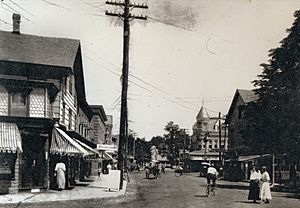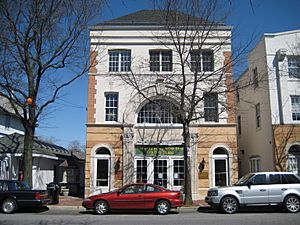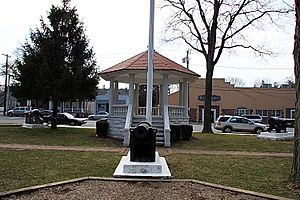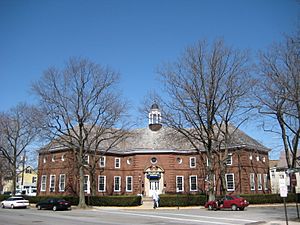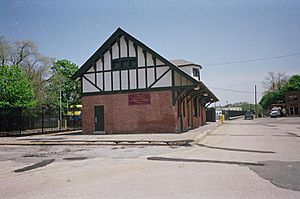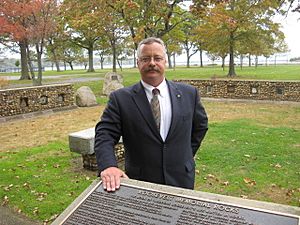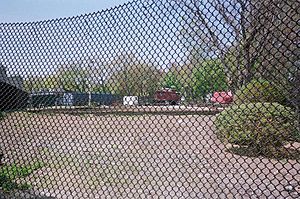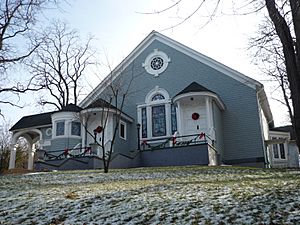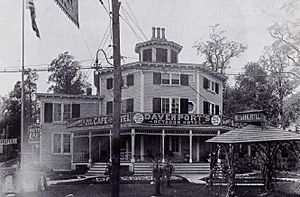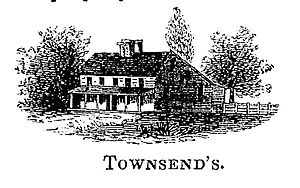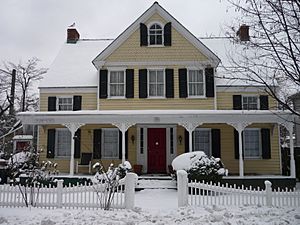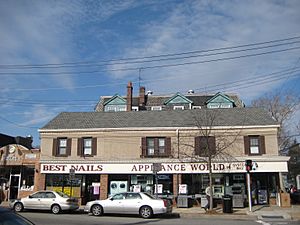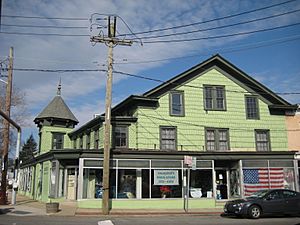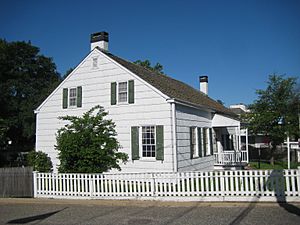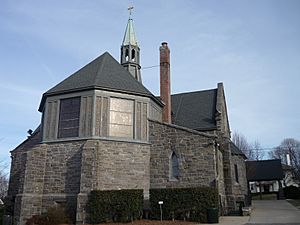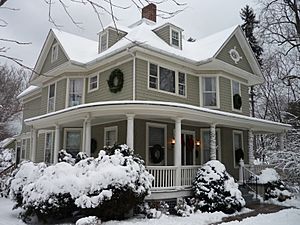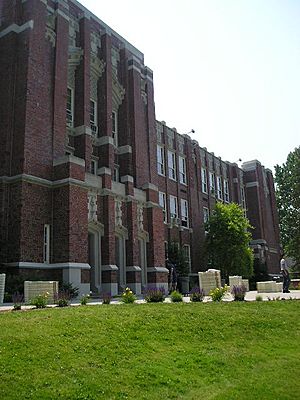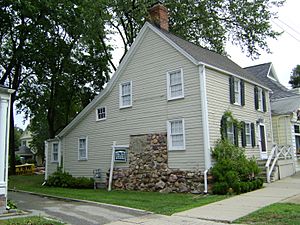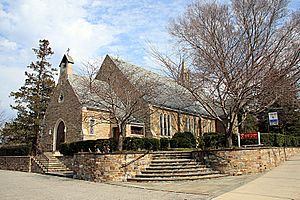Oyster Bay History Walk facts for kids
The Oyster Bay History Walk is a fun path through downtown Oyster Bay, New York. It takes you to 30 amazing historic places! This walk is about 1 mile long and was the first certified American Heart Association Start! Walking Path on Long Island. It's a great way to explore history and get some exercise.
Contents
- Discovering Oyster Bay's Past
- Exploring the Historic Sites
- 1. Welcome to Oyster Bay
- 2. Fleet's Hall: A Community Hub
- 3. Moore's Building: A President's Office
- 4. Oyster Bay Bank Building: First Bank in Town
- 5. Derby-Hall Bandstand: Speeches and Cannons
- 6. U.S. Post Office: A Designed Building
- 7. Long Island Rail Road Station: A Train Hub
- 8. Theodore Roosevelt Memorial Park: A "Breathing Place"
- 9. Oyster Bay Long Island Rail Road Turntable: Turning Trains Around
- 10. Waterfront Center: Oysters and History
- 11. Captain Kidd's Secret Visit
- 12. Wightman Memorial Baptist Church: Oldest Congregation
- 13. Octagon Hotel: A Unique Shape
- 14. The Printery: Home of the Guardian
- 15. Fort Hill and the Townsend Cemetery: An Old Orchard
- 16. Raynham Hall Museum: A Changing Home
- 17. Seely/Wright House: Doctors and Founders
- 18. Ludlam Building: Surviving Fires
- 19. Snouders Drug Store: Oyster Bay's First Telephone
- 20. Hood A.M.E. Zion Church: A Long History
- 21. Earle-Wightman House: A Museum of Early Life
- 22. St. Paul's Methodist Church: Growing Community
- 23. St. Dominic's Church and Chapel: Gothic Beauty
- 24. Oyster Bay Public Library: A Place to Read
- 25. Stoddard House: Family History
- 26. Oyster Bay High School: Modern Learning
- 27. Typhoid Mary's Visit to Oyster Bay
- 28. Wilson House: An Old Saltbox Home
- 29. First Presbyterian Church of Oyster Bay: A Historic Design
- 30. Christ Church of Oyster Bay: Roosevelt's Church
- See also
Discovering Oyster Bay's Past
Oyster Bay has a long and exciting history! The first settlers arrived here in the 1650s. For over 350 years, many important things happened in this area. These events shaped the religious, military, and social history of Colonial America and the United States. The History Walk celebrates some of these moments and the people who lived them. Seven of the places on the walk are even listed on the National Register of Historic Places, which means they are very special!
This tour was created by historian John Hammond, Oyster Bay Historical Society Director Thomas A. Kuehhas, and sound artist Claire Bellerjeau. They worked together to bring Oyster Bay's past to life.
You can even listen to an audio guide as you walk! It helps you understand what makes each spot on the Walk so important. The audio guide was first called Talk of the Town. But in 2008, it changed its name to the Oyster Bay History Walk. This was when the American Heart Association recognized it as the first Start! Walking Path on Long Island.
Exploring the Historic Sites
You can find a map to help you locate all the interesting places on the walk.
1. Welcome to Oyster Bay
The Walk begins at the Baykery Cafe. Here, you'll get a general introduction to Oyster Bay and its rich history.
Many people know Oyster Bay as the home of President Theodore Roosevelt. But there's so much more to discover! Long before Europeans arrived, the Matinecock Indians lived here over a thousand years ago. Later, Dutch and English traders, fishermen, and shipbuilders made Oyster Bay a busy port. Even George Washington's important spy, Robert Townsend, lived here. And did you know the famous pirate Captain Kidd once visited? Even Typhoid Mary spent some time here.
2. Fleet's Hall: A Community Hub
Fleet's Hall was a building in Oyster Bay that served as a key meeting place. It was used for public gatherings, concerts, dances, and dinners. This was especially true when Theodore Roosevelt lived in Oyster Bay. He was Governor of New York State and later President of the United States. Fleet's Hall was also where the first moving picture was shown in Oyster Bay!
3. Moore's Building: A President's Office
After a fire, James Moore built this new grocery store in 1901. He used parts of an older brick wall from 1891. The building had a large ground floor for the store. It also had two tall upper floors for public meetings. President Roosevelt used these upper floors as his Summer Executive Offices! His secretary, William Loeb Jr., and his team handled presidential business here. Special "hotlines" connected the office to Sagamore Hill and the White House. In 1903, the first "round the world" cable message was sent from this building. Moore's Building is on the U.S. National Register of Historic Places.
4. Oyster Bay Bank Building: First Bank in Town
This building was constructed in 1891. It was the very first bank in Oyster Bay! It originally had 3½ stories and a basement. The bank rented out the upper floors to different groups. Masons used the third floor, and doctors and lawyers had offices on the second. A pool hall and tobacco shop were in the basement. The bank itself used the first floor.
When Roosevelt was Governor of New York in 1900, he rented rooms on the second floor. In 1901, he joined the Matinecock Lodge and attended meetings on the third floor.
The building used to be set back from the sidewalk with wide steps. But in 1927, it was moved forward and lowered. Now, you can walk right into the main floor from the street! A three-story addition was also built at the back. The building has recently been updated inside and out.
5. Derby-Hall Bandstand: Speeches and Cannons
This bandstand was a place where Roosevelt and others gave speeches. The original bandstand was taken down in the 1930s. But in 1981, a new one was built to look just like it! It's still used for public speakers today. It was dedicated to Roosevelt's daughter, Ethel Roosevelt Derby, and to Leonard Wood Hall. Hall was a local Congressman who helped organize the rebuilding project.
Around the bandstand, you'll see three cannons.
- One cannon faces the Town Hall. It's a Civil War-era Dahlgren gun. At its base is a tablet made from metal from the USS Maine. The explosion of the Maine helped start the Spanish–American War of 1898. Roosevelt became famous during this war!
- Another cannon is at the bottom of the stairs. It's a Civil War trophy gun from the USS R. R. Cuyler. This ship was used by the Union Navy to block ports in Florida. It's a 30-pound Parrott rifle and weighs a lot! President Roosevelt himself unveiled it in 1903.
6. U.S. Post Office: A Designed Building
Oyster Bay has had several post office locations. But this building was the first one specially designed by an architect! New York architect William Bottomley made it look like a mirror image of the Town Hall across the street. It was finished in 1936. Artists decorated the inside. Ernest Peixotto painted murals showing Oyster Bay's history. Leo Lentelli created terracotta panels and a bust of Theodore Roosevelt. This building is also on the National Register of Historic Places.
7. Long Island Rail Road Station: A Train Hub
The Oyster Bay Railroad Station is the end of this train line. The first station was built in 1889. It was made bigger in 1901 when Roosevelt became President. Many guests came to visit, so more space was needed! A newer station was built nearby later for bigger trains. The original building is now becoming the Oyster Bay Railroad Museum. This historic building is listed on the National Register of Historic Places.
8. Theodore Roosevelt Memorial Park: A "Breathing Place"
This park used to be a marsh where cattle grazed. Theodore Roosevelt once said he wished citizens could make it "a breathing place for all people." Just months after he passed away in 1919, the idea for a park was approved. Land was bought, and work began. In May 1928, a dedication ceremony was held with 5,000 people, a parade, and even planes flying overhead!
9. Oyster Bay Long Island Rail Road Turntable: Turning Trains Around
Oyster Bay is one of the few stations that still has an original turntable. This large spinning platform was built in 1902. It replaced a smaller one that had been moved from Locust Valley. Turntables help turn trains around! This Turntable is listed on the National Register of Historic Places.
10. Waterfront Center: Oysters and History
The area where the WaterFront Center is now used to be Jakobson’s Shipyard. During World War II, they built minesweepers, tugboats, and mini-submarines for the US Navy. Today, it's a place for learning and fun activities.
A special part of the WaterFront Center is the Christeen. She is a U.S. National Historic Landmark and is moored right here! The Christeen is the oldest oyster sloop (a type of sailboat) in the United States. She was built in 1883. After 30 years of harvesting oysters, she was used for cargo and then for pleasure. In 1989, she was left abandoned. But in 1991, a group of Oyster Bay fans bought and restored her!
Oyster Bay produces a huge amount of New York State's oysters and clams. The Christeen is now a floating classroom. Students of all ages learn about old ships and how to protect the marine environment of Oyster Bay.
11. Captain Kidd's Secret Visit
Captain Kidd was a famous privateer (a legal pirate). He sailed to Oyster Bay on June 9, 1699. He anchored offshore, trying to avoid his crew. He thought this was a safer route than the busy waters near New York City.
Local people helped him send a message to his wife without revealing his location. But his secret didn't last long. Just over a month later, he was captured and sent to England.
12. Wightman Memorial Baptist Church: Oldest Congregation
The first Baptist group in Oyster Bay started meeting in 1700. It's the oldest Baptist congregation in New York State! The first minister, Robert Feeks, was appointed in 1724. He was the first ordained minister of any Christian church in Oyster Bay.
The first church building was a simple wooden structure. During the Revolutionary War, British troops reportedly used it, like many other churches. The congregation grew, and a larger church was built on this site in 1806.
In 1882, that second building was moved back and turned to make room for the new church you see today. This current church was finished in 1908. The 1806 building then became a church school.
Since the 1980s, the North Shore Assembly of God has used both buildings. They have kept the inside looking original. You can still see carved pews, woodwork, tin ceilings, a pipe organ, and stained glass windows.
13. Octagon Hotel: A Unique Shape
Luther Jackson built the Nassau House in 1851 as a place for political and social gatherings. It was later called the Acker Nassau House. In 1887, Phillip and Mary Lavelle bought it and renamed it the Octagon Hotel. Mary Lavelle made many modern improvements. In 1889, she added central heating. In 1890, she built a power plant that gave Oyster Bay its first electric lights! She even had her own direct phone line to New York City.
President Roosevelt's secretary had a small office here in 1899. But it was too small, so they moved to the nearby Oyster Bay Bank Building.
This building is the only known octagonal (eight-sided) building in this part of Long Island. It might even be the only octagon-shaped hotel in the United States! There's a plan to restore the building to its original look, which many community groups are excited about.
14. The Printery: Home of the Guardian
The Oyster Bay Guardian is a weekly newspaper. It was started by Nelson Disbrow in 1899. In 1905, Disbrow bought his own property and built The Printery in 1906. This brown shingled building still stands today. The Guardian newspaper was printed here until 1967. The Printery has continued to be used as a print shop.
The Guardian newspaper is still published today, though from a different location.
15. Fort Hill and the Townsend Cemetery: An Old Orchard
This spot was once a huge apple orchard! An old fort also stood here. While the fort is gone, this hill is special to the Townsend family. It's one of their oldest graveyards. John Townsend is thought to be the first person buried here in 1668. His headstone is very old, but a bronze marker shows he came from England and owned this land.
16. Raynham Hall Museum: A Changing Home
The Raynham Hall Museum building has changed a lot over time! It was first built in 1738 as a four-room house. In 1740, Quaker merchant Samuel Townsend and his wife moved in. As their family grew, they added four more rooms, making it a saltbox style house.
In 1851, Samuel's grandson, Solomon Townsend II, added a three-story water tower. This gave the house the first kitchen in town with running water! In the 1870s, Solomon turned the house into a Victorian villa.
In 1941, the building went to the Daughters of the American Revolution. Then, in 1947, the Town of Oyster Bay took it over. The Town Council decided to restore it to its 18th-century saltbox look. In 1959, the Victorian additions were removed.
Today, the museum has two parts. The front rooms show how people lived in the 1770s (during the Revolutionary War). The back of the house shows the style of the 1870s, when Solomon lived there.
This building is on the National Register of Historic Places and is an active museum you can visit!
17. Seely/Wright House: Doctors and Founders
This house, across from Raynham Hall Museum, was built in 1830 for Dr. Ebeneezer Seely. Dr. Seely was a busy man! Besides being a doctor, he was the Town Supervisor of Oyster Bay and a School Commissioner. There's a story that he even entertained President Martin van Buren here!
Dr. Seely's daughter married Joseph Wright, a local blacksmith. Joseph Wright was a descendant of Peter Wright, one of Oyster Bay's founders. Peter Wright helped buy the land from the Matinecock Indians in 1653. The Wright family lived in this house for many years.
18. Ludlam Building: Surviving Fires
James Ludlam opened a store in 1836. After a fire destroyed his first store, he built this two-story building, known as The Ludlam Building. It's in the Greek Revival style. His sons later sold it to Roger Royce, who ran a grocery store. In 1907, another fire started nearby. The Ludlam Building was saved, only getting scorched!
Later, the Kursman brothers ran a dry goods and clothing store here. But on April 12, 1932, fire struck again. This time, the inside of the Ludlam Building was destroyed. Only the brick walls remained. David Bernstein rebuilt it and ran a popular men's clothing store called Dave’s Shop for over thirty years. This brick building is one of the oldest commercial storefronts in the village. For over 20 years, it has been home to Appliance World.
19. Snouders Drug Store: Oyster Bay's First Telephone
Snouders Drug Store has been here since 1884. It's the oldest business in Oyster Bay that has been open continuously! Abel Miller Conklin started the drug store. His son-in-law, Andrew Snouder, took over after Conklin passed away.
In 1887, Snouder installed the first telephone in Oyster Bay! For several years, it was the only one in town. Even President Roosevelt's home, Sagamore Hill, didn't have a phone at first. Snouder's son, Arthur, would carry messages to Roosevelt.
The telephone made Snouders a popular gathering spot. In 1900, part of the store was set aside for the telephone service. This allowed the switchboard to stay open late. Later that year, Snouder officially changed the name to Snouders Drug Store. Many reporters also came here to use the phones to cover news about Theodore Roosevelt.
In 1889, a soda fountain was added. Young people loved to hang out here! It was a social center for generations, all the way into the 1970s. The outside of the store was returned to its original color in the 1990s.
20. Hood A.M.E. Zion Church: A Long History
The Hood African Methodist Episcopal Zion Church is special. It's the oldest Oyster Bay congregation still holding services in its original church building! African American families founded the congregation in 1848. In 1856, a small wooden building was built on land donated by Edward Weekes. In 1937, after raising money, the wooden church was covered with a brick exterior.
The church was first called the First African Methodist Episcopal Zion Church. Later, it was renamed the Hood A.M.E. Zion Church to honor an early bishop, James Walker Hood.
The congregation faced financial challenges for many years. But by 1937, they could pay their pastor and add electric lights and the brick exterior. Reverend Kenneth Nelson has led the congregation since 1981.
21. Earle-Wightman House: A Museum of Early Life
This house, named for two Baptist ministers from the 1800s, was first built around 1720 as a small one-room home. By 1897, it had been moved to its current spot and made larger.
In 1966, the house was given to the Town of Oyster Bay for the Oyster Bay Historical Society. The society uses it as their headquarters and a museum. Two rooms show how people lived in 1740 and 1830.
The 1740 room shows how an 18th-century tradesman might have lived. The 1830 room shows how a minister would have entertained guests. The garden behind the house has been restored to look like an 18th-century garden. It has pretty plants and herbs used for medicine, cooking, and fragrance.
The Historical Society also has a research library. It's full of books, photos, maps, and documents about Oyster Bay's military, maritime, and religious history. They also have family history records.
22. St. Paul's Methodist Church: Growing Community
The first Methodists in Oyster Bay formed a group in 1812. They used space at the Oyster Bay Academy for services. In 1858, they built a small church. In 1895, Joseph B. Wright, the blacksmith, bought that building. The congregation then moved to St. Paul's, which they had been building since 1891.
In 1904, a new pipe organ was installed. The famous philanthropist Andrew Carnegie paid for half of it! By 1913, the church had grown a lot. To make more room, the entire building was raised using jacks. A basement was dug out, and new rooms, including a kitchen, were built.
A tall spire on the bell tower was hit by lightning in the 1920s and had to be removed. The "Carnegie" organ is no longer there, and the inside has a more modern look.
In 1988, St. Paul’s Methodist Church joined another congregation. The Bethel Pentecostal Church then moved into this building. Later, Bethel moved to Westbury. In 1999, the North Shore Community Church made it their new home. Another local church, El Shaddai Pentecostal Church, holds services in North Shore’s chapel.
This building is listed on the National Register of Historic Places.
23. St. Dominic's Church and Chapel: Gothic Beauty
This beautiful Gothic-style granite building was first dedicated on Thanksgiving Day in 1897. The original covered entrance leads to the chapel. Inside, you can hear the original pipe organ. It's a special American-made Hook and Hastings Opus tracker organ, built in 1901. It's one of only three of its kind in the United States! St. Dominic’s Roman Catholic Church has grown a lot. They started a grammar school in 1922 and a high school in 1928. In 1968, they began building a large, modern church across the street. Today, St. Dominic’s has eleven buildings on its six-acre campus.
24. Oyster Bay Public Library: A Place to Read
Oyster Bay had several "reading rooms" before this library. In 1893, the People’s Library and Reading Room opened. This building was first built in 1901. Theodore Roosevelt laid a cornerstone in 1899 on land donated by Mrs. Harriet Swan. Andrew Carnegie also supported the library. The brick building you see on the left is where the original wood-frame building stood. The house on the right was built in 1890. It was bought and combined with the original building in 1975. In 1994, glass-and-brick additions were added behind the house to make the library even bigger.
25. Stoddard House: Family History
Stoddard House, at 107 East Main Street, was built in the 1890s for G. B. Stoddard. For many years, starting in 1980, the house was used for offices and historical archives. Two organizations, the Townsend Society of America and the Underhill Society of America, used it. These groups preserve family history materials, deeds, and artifacts of the Townsend and Underhill families. These families settled in Oyster Bay in the mid-1600s. Henry Townsend and Captain John Underhill were early members of these families.
26. Oyster Bay High School: Modern Learning
Several school buildings existed before this one. This Art Deco building replaced the first high school, which was built in 1901. The new school had modern features. These included classroom loudspeakers, an auditorium with a balcony, and a central vacuuming system. It also had one of the most modern gymnasiums in Nassau County! After 70 years, the gym was updated. In 2000, a new, state-of-the-art gymnasium was built. New library-media center additions were also made in 2000.
27. Typhoid Mary's Visit to Oyster Bay
Mary Mallon worked as a cook in the New York area between 1900 and 1907. In the summer of 1906, she worked for a wealthy family who rented a home in Oyster Bay. From August 27 to September 3, six people in the house became sick with typhoid fever. Doctors in Oyster Bay said typhoid fever was "unusual" there at that time.
The homeowners were worried they wouldn't be able to rent their house again. So, they hired George Soper to investigate. Soper found that the family had a new cook, Mary Mallon, who left shortly after the sickness started. He described her as an Irish woman, about 40 years old, tall, heavy, and appearing perfectly healthy. Soper later found Mary Mallon in New York.
28. Wilson House: An Old Saltbox Home
This is one of the oldest houses in Oyster Bay still standing in its original spot. This saltbox style house dates back to the 1750s. A saltbox house has a sloping rear roof that ends low to the ground. Two legends tell of famous visitors here. It's said that Marquis de Talleyrand stayed a night in the 1790s while escaping trouble in France. President George Washington is also rumored to have stopped here and spoken to children from the porch on April 24, 1790. These stories add extra interest to this special old home.
29. First Presbyterian Church of Oyster Bay: A Historic Design
The first Presbyterian ministry in Oyster Bay began in 1842. After being in different places, they finally settled here. In 1872, led by Pastor Benjamin L. Swan, work started on this beautiful church on the hill. The architect was J. Cleveland Cady, who was just starting his career. He later designed the original Metropolitan Opera House and the American Museum of History. This church was his first, and the only one he designed in the unique Carpenter Gothic style. Mr. and Mrs. Theodore Roosevelt, Sr., attended services here. Mr. Roosevelt’s funeral was held here in 1878.
30. Christ Church of Oyster Bay: Roosevelt's Church
Christ Church, founded in 1705, is a historic Episcopal church in Oyster Bay, New York. Several church buildings have stood on this site over the years. One even served as soldiers' barracks during the Revolutionary War! In the 1870s, a Carpenter Gothic style building was built. In 1925, it was greatly enlarged and covered in stone. These additions also included beautiful stained glass windows. President Theodore Roosevelt attended church here, and his wife and children were active members. The church is famous for holding Roosevelt’s funeral service in 1919.
See also
- List of Town of Oyster Bay Landmarks
- New York State Historic Markers, Nassau County, Town of Oyster Bay
- National Register of Historic Places listings in Nassau County, New York
- Similar walks:
- Baltimore Heritage Walk
- Boston Freedom Trail
- New London Heritage Trail


